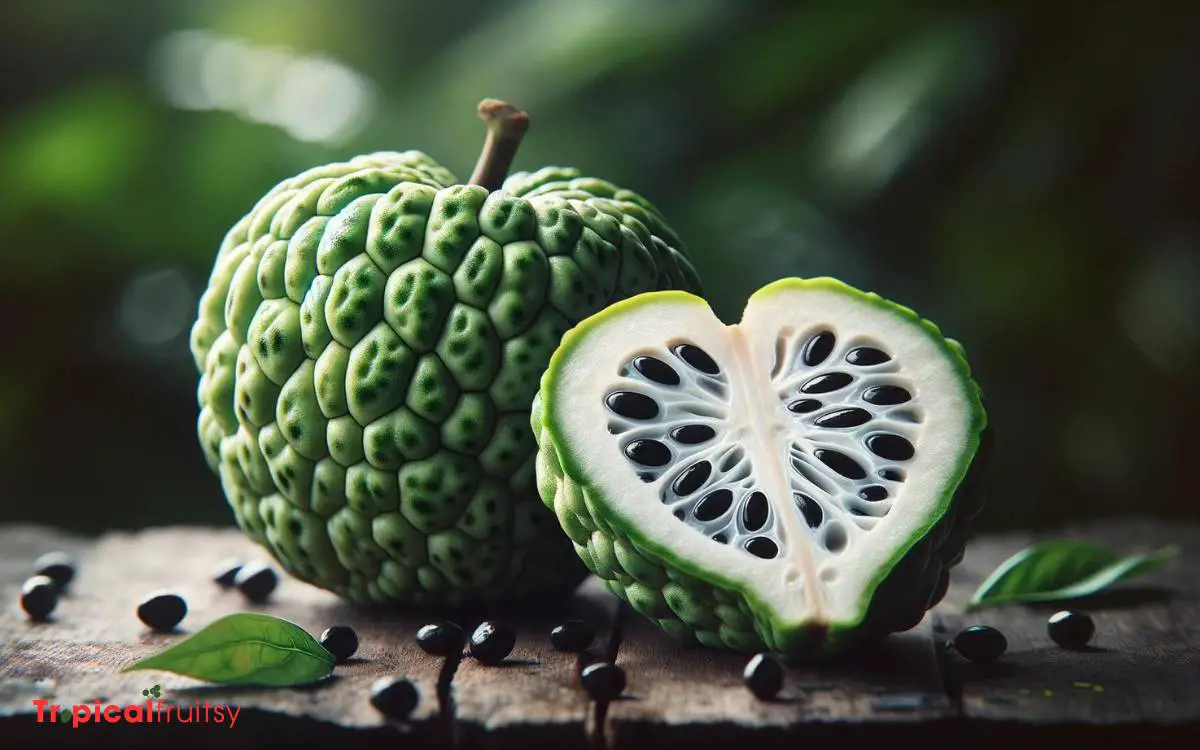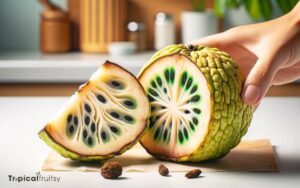What Is a Cherimoya Fruit? Unveiling the Exotic!
The cherimoya, also known as the custard apple, is a tropical fruit known for its creamy texture and unique flavor resembling a mix of banana, pineapple, and strawberry.
Originating from the Andean region of South America, cherimoya boasts a variety of health benefits due to its rich content of vitamins, minerals, and fiber.
The cherimoya fruit has a distinctive heart shape with a leathery green skin and soft, white flesh inside.
It’s a nutrient-dense fruit containing:
Cherimoyas are versatile in culinary uses and can be eaten fresh or used in various recipes:
When selecting a cherimoya, it should be firm but slightly soft to the touch, indicating ripeness.
Discover the cherimoya, a nutrient-packed fruit with a flavor that dances on the taste buds and nourishes the body.

Key Takeaway
Cherimoya Fruit Benefits and Culinary Guide
| Nutrient | Benefit | Culinary Uses | Selection Tips |
|---|---|---|---|
| Vitamin C | Immune support, skin health | Eaten raw, smoothies | Firm but yields slightly to touch |
| Potassium | Heart and muscle function | Desserts, shakes | Green leathery skin, no blemishes |
| Dietary Fiber | Digestive health, satiety | Ice cream, custard | Pleasantly sweet aroma |
Origins and History
Where did the cherimoya fruit originally flourish before it captivated taste buds worldwide? It’s indigenous to the Andes mountains in South America, thriving in Colombia, Ecuador, Peru, and Bolivia.
Cherimoya, or Annona cherimola, is a species in the Annonaceae family, which notably includes other custard apples.
The cherimoya tree prefers altitudes between 700 to 2400 meters, where it benefits from temperate climates. It’s a subtropical plant, sensitive to frost, which limits its cultivation to specific regions.
The tree’s cultivation techniques are refined, requiring hand-pollination due to the natural pollinators being absent in non-native regions. This labor-intensive process is essential for fruit production outside its native range.
Consequently, cherimoya exemplifies a crop that’s both geographically and botanically specialized.
Physical Description
The cherimoya fruit typically exhibits a green, heart-shaped exterior with a creamy, white flesh dotted with black seeds. Its skin is often described as scaly or having a texture reminiscent of overlapping warty segments.
On average, a cherimoya may weigh between 150 to 500 grams, and its dimensions can vary, but it generally measures 10 to 20 centimeters in length.
The fruit’s flesh offers a custard-like consistency, contributing to its nickname, ‘custard apple.’ Cherimoya’s seeds are inedible and embedded within the flesh in conical segments.
While its surface may appear rigid, the fruit’s skin is relatively thin and yields to gentle pressure, indicating ripeness.
Understanding the cherimoya’s physical traits allows for better recognition and handling—attributes that segue into the importance of its nutritional profile.
Nutritional Profile
Cherimoya’s rich nutritional profile complements its unique physical characteristics, offering a variety of essential vitamins and minerals.
This fruit isn’t only a delight to the palate but also a powerhouse of nutrients, critical for maintaining good health.
Here’s a breakdown of its key nutritional components:
- Vitamin C: A potent antioxidant, vitamin C in cherimoya contributes to immune defense and skin health.
- Dietary Fiber: Cherimoya is high in dietary fiber, which aids in digestion and can help regulate blood sugar levels.
- B Vitamins: It contains several B vitamins, including niacin and riboflavin, which are essential for energy metabolism and maintaining healthy cells.
- Minerals: Cherimoya provides minerals such as potassium and magnesium, which are vital for heart health and muscle function.
Culinary Uses
Cherimoya’s creamy texture and sweet flavor make it a versatile ingredient in the culinary world.
Its pulp is often blended into smoothies, adding a rich, tropical twist that complements other fruits.
As a dessert component, cherimoya elevates the taste profile of custards, ice creams, and fruit salads with its distinctive notes.
Exotic Smoothie Ingredient
Cherimoya fruit lends a creamy texture and tropical flavor to smoothies, making it a favorite among exotic fruit enthusiasts.
When incorporated into smoothies, cherimoya’s custard-like consistency elevates the beverage’s mouthfeel, while its unique flavor profile, described as a blend of banana, pineapple, and strawberry, adds a nuanced dimension.
To optimize the use of cherimoya in smoothies, consider the following technical guidelines:
- Preparation: Remove the seeds and skin, using only the flesh.
- Proportion: For balance, use a half-cup of cherimoya per 16 ounces of smoothie.
- Combination: Pair it with complementary fruits like banana or mango for flavor synergy.
- Enhancement: Accentuate cherimoya’s flavor with a hint of lime or vanilla extract.
This analytical approach ensures that cherimoya’s culinary potential is fully realized in smoothie applications.
Tropical Dessert Inspiration
Beyond enhancing smoothies, cherimoya’s creamy flesh also transforms tropical desserts, offering a luxurious base for ice creams, sorbets, and mousse.
When processed into these desserts, cherimoya imparts a velvety texture and a complex flavor profile that features notes of banana, pineapple, and a hint of vanilla.
The subtlety of its sweetness allows it to blend harmoniously with other tropical ingredients without overpowering them.
| Dessert Type | Key Qualities |
|---|---|
| Cherimoya Ice Cream | Rich, Creamy Texture; Subtle Sweetness |
| Cherimoya Sorbet | Light, Refreshing; Intense Flavor |
| Cherimoya Mousse | Airy, Silky Consistency; Delicate Taste |
| Tropical Fruit Salad | Vibrant, Juicy; Diverse Textures |
In an analytical examination, the incorporation of cherimoya contributes significantly to the sensory enjoyment of desserts. The fruit’s adaptability makes it an ideal candidate for culinary experimentation.
Purchasing and Storage
When selecting a cherimoya, it’s important to choose one that’s firm but yields slightly to pressure, ensuring optimal ripeness for consumption.
The skin should appear green without significant brown spots, which may indicate overripeness or bruising.
Analyzing the fruit’s weight can also provide insight into its maturity; a heavier cherimoya typically signals a juicier fruit.
To properly store and maintain cherimoya’s quality:
- Keep unripe cherimoyas at room temperature until they achieve desired softness.
- Refrigerate ripe cherimoyas to slow down the ripening process.
- Consume refrigerated cherimoyas within 2-3 days to enjoy their peak flavor and texture.
- Avoid freezing, as this can drastically alter the fruit’s cellular structure, leading to mushiness upon thawing.
Health Benefits
Delving into its nutritional profile, we find that cherimoya isn’t only a delicious treat but also boasts a host of health benefits, including being rich in vitamins, minerals, and fiber.
It’s particularly abundant in vitamin C, a potent antioxidant crucial for immune function, skin health, and the synthesis of collagen.
The fruit’s B vitamins, such as thiamine, riboflavin, and niacin, play essential roles in energy metabolism and central nervous system maintenance.
Moreover, cherimoya’s mineral content includes notable amounts of potassium, which aids in maintaining electrolyte balance and cardiovascular health.
The fiber in cherimoya contributes to digestive health, assisting in bowel regularity and potentially reducing the risk of chronic diseases.
Its bioactive compounds, including flavonoids and alkaloids, may exhibit anti-inflammatory and anti-cancer properties, though further research is warranted to fully substantiate these effects.
Where Does Cherimoya Come From
Cherimoya, often described as a custard apple, is native to the Andean highlands of South America.
This exotic fruit is believed to have originated in the regions that are now Colombia, Ecuador, Peru, and Bolivia.
The cherimoya has been cultivated and enjoyed in its native habitat for centuries, even before the rise of the Incan Empire.
Spanish explorers and colonists introduced the fruit to other parts of the world during the 16th and 17th centuries, including Europe and other Spanish colonies, helping to spread its cultivation to various subtropical regions around the globe.
Conclusion
In the tapestry of nature’s bounty, the cherimoya stands out as a masterpiece, akin to an edible Monet. This fruit, steeped in history, offers a complex nutritional profile and versatile culinary potential.
Savvy consumers recognize its value, storing this custard-like treasure with care to harness its health benefits.
Analytically, the cherimoya’s contributions to diet and well-being are undeniable, painting a vivid picture of nature’s ingenuity in every creamy, flavorful bite.






